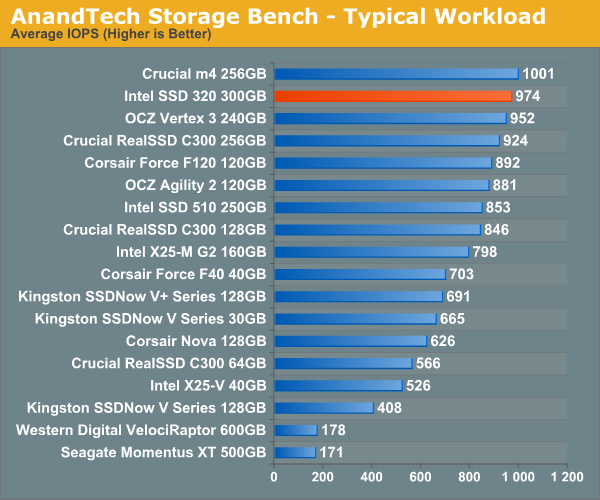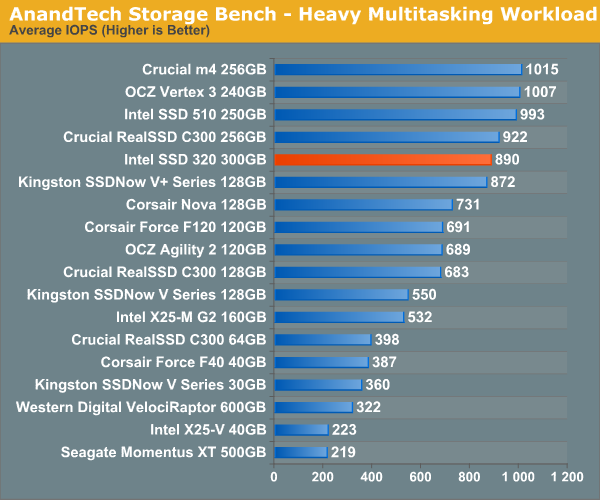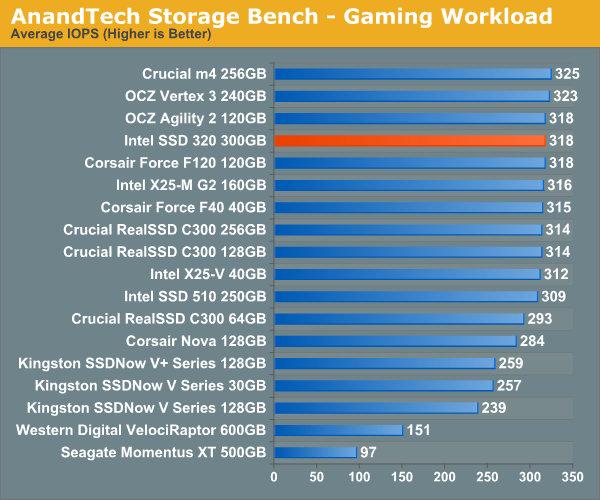The Intel SSD 320 Review: 25nm G3 is Finally Here
by Anand Lal Shimpi on March 28, 2011 11:08 AM EST- Posted in
- IT Computing
- Storage
- SSDs
- Intel
- Intel SSD 320
AnandTech Storage Bench 2010
To keep things consistent we've also included our older Storage Bench. Note that the old storage test system doesn't have a SATA 6Gbps controller, so we only have one result for the 6Gbps drives.
The first in our benchmark suite is a light/typical usage case. The Windows 7 system is loaded with Firefox, Office 2007 and Adobe Reader among other applications. With Firefox we browse web pages like Facebook, AnandTech, Digg and other sites. Outlook is also running and we use it to check emails, create and send a message with a PDF attachment. Adobe Reader is used to view some PDFs. Excel 2007 is used to create a spreadsheet, graphs and save the document. The same goes for Word 2007. We open and step through a presentation in PowerPoint 2007 received as an email attachment before saving it to the desktop. Finally we watch a bit of a Firefly episode in Windows Media Player 11.
There’s some level of multitasking going on here but it’s not unreasonable by any means. Generally the application tasks proceed linearly, with the exception of things like web browsing which may happen in between one of the other tasks.
The recording is played back on all of our drives here today. Remember that we’re isolating disk performance, all we’re doing is playing back every single disk access that happened in that ~5 minute period of usage. The light workload is composed of 37,501 reads and 20,268 writes. Over 30% of the IOs are 4KB, 11% are 16KB, 22% are 32KB and approximately 13% are 64KB in size. Less than 30% of the operations are absolutely sequential in nature. Average queue depth is 6.09 IOs.
The performance results are reported in average I/O Operations per Second (IOPS):

If we strip 6Gbps out of the equation completely, the SSD 320 does very well in our old light workload. You're looking at performance that's at the top of the pack from the mainstream offering.
If there’s a light usage case there’s bound to be a heavy one. In this test we have Microsoft Security Essentials running in the background with real time virus scanning enabled. We also perform a quick scan in the middle of the test. Firefox, Outlook, Excel, Word and Powerpoint are all used the same as they were in the light test. We add Photoshop CS4 to the mix, opening a bunch of 12MP images, editing them, then saving them as highly compressed JPGs for web publishing. Windows 7’s picture viewer is used to view a bunch of pictures on the hard drive. We use 7-zip to create and extract .7z archives. Downloading is also prominently featured in our heavy test; we download large files from the Internet during portions of the benchmark, as well as use uTorrent to grab a couple of torrents. Some of the applications in use are installed during the benchmark, Windows updates are also installed. Towards the end of the test we launch World of Warcraft, play for a few minutes, then delete the folder. This test also takes into account all of the disk accesses that happen while the OS is booting.
The benchmark is 22 minutes long and it consists of 128,895 read operations and 72,411 write operations. Roughly 44% of all IOs were sequential. Approximately 30% of all accesses were 4KB in size, 12% were 16KB in size, 14% were 32KB and 20% were 64KB. Average queue depth was 3.59.

Crank up the workload and the 320 falls a bit behind the rest of the competitors. Last year's heavy multitasking workload is nothing compared to what we introduced earlier this year, so it's still pretty light by comparison but it's clear for normal usage the 320's 3Gbps performance is quite good.
The gaming workload is made up of 75,206 read operations and only 4,592 write operations. Only 20% of the accesses are 4KB in size, nearly 40% are 64KB and 20% are 32KB. A whopping 69% of the IOs are sequential, meaning this is predominantly a sequential read benchmark. The average queue depth is 7.76 IOs.











194 Comments
View All Comments
jwilliams4200 - Wednesday, March 30, 2011 - link
More OCZ spin doctoring. I was talking about using the drive heavily in a average consumer manner. For example, running CDM a couple times. The notorious Sandforce flaw causes the write speed of the SSD to slow down. No where is that flaw documented, so it is really worse than just a design flaw, it is a bug. If it were a known design flaw, there should be something in the spec sheet stating under what conditions the write speed of the drive will slow down. But there is nothing in the official specifications about that notorious Sandforce bug.sean.crees - Wednesday, March 30, 2011 - link
And no other companies have undocumented issues?How about my first gen Intel SSD's that now run at 1/10th their rated speeds? Where was it documented that this would happen to me?
So by your reasoning we should toss all Intel SSD's out of the window now right?
jwilliams4200 - Wednesday, March 30, 2011 - link
Intel G1 SSDs do not run at one-tenth their rated speed. There was a slowdown bug, perhaps a factor of two, but Intel long since fixed that with a firmware update.kmmatney - Wednesday, March 30, 2011 - link
Having several each of Intel and OCZ Agility SSDs, I can tell you that Intel's garbage collection is better, especially in first generation SSDs. I also have an Intel 80GB G1, and is is a little slower than new, but it hasn't slown down nearly as much as some of the OCZ drives I have do. Theya re all still much faster than spindle hard drives. I really do wish that Intel would at least enable manual TRIM of the G1 drives with the SSD Toolbox - but at least the grabage collection is very good.Frallan - Tuesday, March 29, 2011 - link
Im a happy Intel G2 user today but my 160 GB is running out bc of bl**dy Steam and their weekend/holiday offers. I have waited for the nexty generation of the Inteldrives bc of my experience with the G2 but with this they are 30% to expensive or 50% to slow.
Intel has failed in either pricing since this drive is a valuedrive or in execution since this is a slow drive. A year ago I would have stood in line allready but now it seems as if Ill have to go with the SandForce.
Just my 0.02 USD
/F
fackamato - Tuesday, March 29, 2011 - link
Same here. I also have the G2 160GB (good price on eBay almost a year ago). But the next one will not be this G3 drive, most likely something Sandforce.marraco - Tuesday, March 29, 2011 - link
Both the Intel 320 300GB and Intel 510 250GB are easily destroyed on price and/or capacity and/or performance by RAID 0 of Intel 320 40GB, 80GB, or Intel 510 120GB (in RAID 0 of 2, 3, or 4 units).I would only recommend Intel 320 80GB or Intel 510 120GB in different RAID 0 setups, but they were not tested.
Given the scalability of SSD units, the price/performance ratio is one of the more important aspects of SSD reviews. I wish Anandtech were giving more attention to the best price/performance in RAID 0.
NCM - Tuesday, March 29, 2011 - link
Remember what the zero in Raid 0 denotes...NCM - Tuesday, March 29, 2011 - link
...It's the amount of data you'll have left if any one member of the array fails.marraco - Wednesday, March 30, 2011 - link
I don't care, since I don't store data on SSD, and I have cheap terabytes of data to automatically store periodic images.